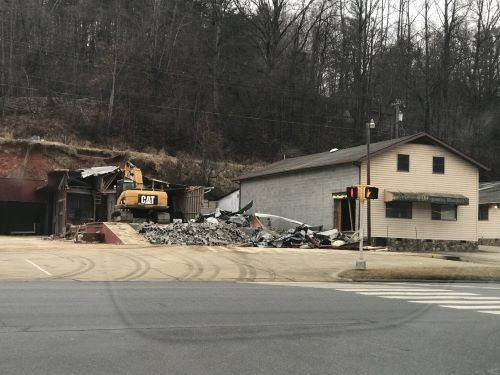story co-written with Jake Harkey
Part 2 of the serial of stories published in The Sylva Herald on Jan. 24 edition
The N.C. Department of Transportation plans to reconfigure N.C.107 through Sylva’s commercial corridor for safety reasons. In the summer of 2021 NCDOT began work on the road.

According to Sylva lawyer and roads activist Jay Coward of the Sylva law firm Coward, Hicks and Siler, there are 152 parcels that will be impacted by the road and of those 20 businesses and seven residential properties will have to relocate.
Sylva is expecting to lose tax revenue from the businesses that are relocating or closing. Business owners are not sure how once the work starts it will impact their business.
“I have contacted other towns that have had similar projects, and also the NCDOT and there is really not a town with a project that’s comparable to this because so much of this is happening in our one commercial corridor,” Sylva town Manager Paige Dowling said.

During a candidate forum last October, then-candidate for mayor Johnny Phillips said that the road construction would cause $300,000 loss in tax revenue.
“That is an estimate and there really is no way to predict a firm number,” Dowling said. “However, it is a good prediction. We won’t start to realize the impact on the taxes and revenue until June 2025.”
Town leaders hope to limit the revenue loss the town and Jackson County must deal with.
Seeking more revenue
“Absolutely we are going to try to look for any type of revenue stream to offset the burden on the taxpayers,” Dowling said. “We are trying to offset this burden on the taxpayers with other growth within the town and other economic development incentives. As the corridor is safer, more people are going to be willing to shop there and more businesses will open.”
Sylva’s economic development director, Bernadette Peters, said that the town has initiatives underway to try and fill some existing spaces and rehab these buildings to increase their value.
Some of these initiatives include working with business owners to improve and expand their property use, along with talking with new entities that want to start their business in Sylva, Peters said.
Sylva leaders are encouraging businesses to relocate somewhere in Sylva and already over 10 businesses have relocated within the town limits.
“The redevelopment of the corridor and the buildings and businesses that will be there will add value to the tax revenue that we need and really make Sylva a more updated and better place,” Peters said.
Positive thinking
Both Peters and Dowling are optimistic about the future and what the new road will bring.
“I think long term as Western Carolina University and Jackson County continue to grow, drivers will need this,” Dowling said. “I do believe that the long term benefits outweigh what is going to happen with construction.”
By June 2025 demolition should be complete, all the utility relocation will be underway or finished, and the actual construction on the road will be able to begin and be completed within two years.
Coward is not that optimistic on the timeline.
“The project from East LaPorte to Tuckasegee, just up the road from Western Carolina University was started in 2016,” he said. “It was supposed to be finished by 2020. It’s three years past schedule, so based on the experience we have right here in this community, no, that time table is probably not correct.”
Coward predicts a decade of chaos while the construction is ongoing.
However, with all that is happening it may take a while for this new expansion of the road to finally pay off.
“I think that Sylva and Dillsboro, Webster and Cullowhee, is a vibrant, alive place and it’s going to survive, but it’s going to have like I said, a decade of payoffs and then as people see investment opportunities, it’ll probably get built back. But it’ll be 20 years from now before it’s got that vibrancy that it’s got right now, or that it had two years ago,” Coward said.
Abigail Queen and Lauren Ramsey contributed to the story. The story is produced as part of collaboration with The Sylva Herald and supported by small grant from the Center for Community News.


